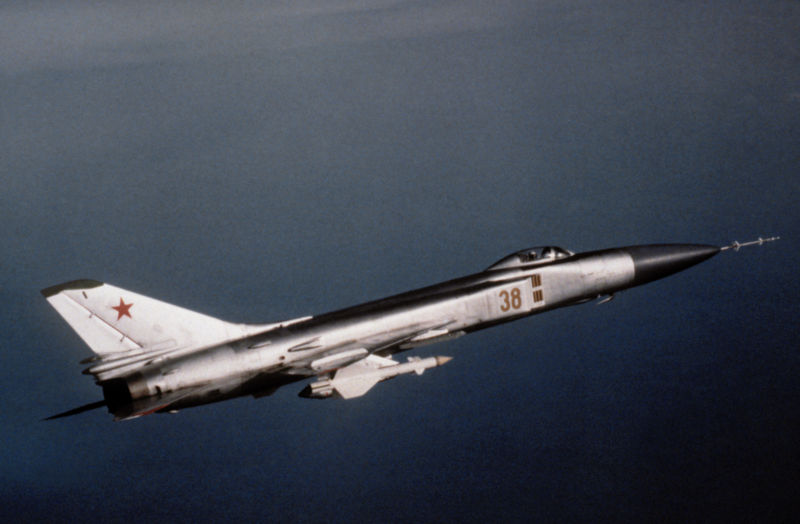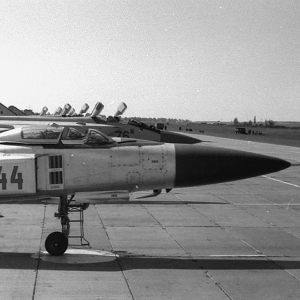- Joined
- Apr 14, 2019
- Messages
- 536
- Points
- 318
***05/19/19: Updated with new pics***
My next thread! Behold the Sukhoi Su-15, known by NATO reporting name Flagon, noble mainstay interceptor of the Soviet Air Defence forces. This is another aircraft that I have been enamored with for a long time so would appreciate any additional info or discussion you folks may be able to contribute. Cold War birds are the best.
Background:
The Sukhoi Su-15 (NATO reporting name: Flagon) is a twinjet supersonic interceptor aircraft developed by the Soviet Union. It entered service in 1965 and remained one of the front-line designs into the 1990s. The Su-15 was designed to replace the Sukhoi Su-11 and Sukhoi Su-9, which were becoming obsolete as NATO introduced newer and more capable strategic bombers.
Variants:

Sources, links, etc...
Wiki

 en.wikipedia.org
en.wikipedia.org
Write-up on a less glamorous and very tragic incident in the history of the Su-15. This is the shootdown of Korean Air Lines KAL 707 by a Soviet Su-15.

 nationalinterest.org
nationalinterest.org
Full Gallery
My next thread! Behold the Sukhoi Su-15, known by NATO reporting name Flagon, noble mainstay interceptor of the Soviet Air Defence forces. This is another aircraft that I have been enamored with for a long time so would appreciate any additional info or discussion you folks may be able to contribute. Cold War birds are the best.
Background:
The Sukhoi Su-15 (NATO reporting name: Flagon) is a twinjet supersonic interceptor aircraft developed by the Soviet Union. It entered service in 1965 and remained one of the front-line designs into the 1990s. The Su-15 was designed to replace the Sukhoi Su-11 and Sukhoi Su-9, which were becoming obsolete as NATO introduced newer and more capable strategic bombers.
Variants:
- T-58: Prototype of Su-15.
- Su-15 (Flagon-A): First production version.
- T-58VD (Flagon-B): One-off prototype using three Kolesov lift-jets in the centre fuselage to provide STOL capability. Not mass-produced.
- Su-15UT (Flagon-C): Trainer version without radar and combat capability, in use since 1970.
- Su-15 (Flagon-D): Version with extended wingtips built since 1969.
- Su-15T (Flagon-E): Version equipped with Volkov Taifun radar.
- Su-15TM (Flagon-F): Improved Su-15T version equipped with Taifun-M radar and additional aerodynamic modifications, in use since 1971. New radome design for improving radar performances.
- Su-15UM (Flagon-G): Trainer version of Su-15TM without radar but with combat capability, built between 1976 and 1979.
- U-58UM: Prototype of Su-15UM with Taifun-M radar, not entered serial production.
- Su-15Sh: Proposed supersonic ground-attack aircraft, offered in 1969. Not built.
- Su-15-30: Proposed version sharing the radar and missiles of the MiG-25; not built.
- Su-15bis: Converted Su-15TM with R-25-300 engines of 69.9 kN (15,652 lb) afterburning thrust for improved performance; approved for series production, but not built because of a shortage of the engines.
- Su-19 (T-58PS): Proposed advanced version with Tumansky R-25-300 engines, ogival wing, and additional pylons for missiles. Not built.
- Crew: 1
- Length: 19.56 m (72 ft 3 in)
- Wingspan: 9.43 m (30 ft 11 in)
- Height: 4.84 m (15 ft 10 in)
- Wing area: 36.6 m² (394 ft²)
- Empty weight: 10,760 kg (23,720 lb)
- Loaded weight: 17,200 kg (37,920 lb)
- Max. takeoff weight: 17,900 kg (39,460 lb)
- Powerplant: 2 × Tumansky R-13-300 turbojets
- Dry thrust: 40.21 kN (9,040 lbf) each
- Thrust with afterburner: 70.0 kN (15,730 lbf) each
- Maximum speed: Mach 1.81 (2,230 km/h; 1,386 mph) with 2 × K-8 or 2 × R-60 air-to-air missiles at an altitude of 12,000 m (39,370 ft)
- Combat radius: 725 km (450 mi; 390 nmi)
- Combat range: 1,380 km (860 mi; 745 nmi)
- Ferry range: 1,700 km (1,060 mi; 920 nmi)
- Service ceiling: 18,100 m (59,380 ft)
- Rate of climb: 228 m/s (45,000 ft/min)
- Wing loading: 102.4 lb/ft² (555 kg/m²)
- Maximum g-load: 6.5 g
- Guns: 2 × UPK-23 gun pods with 2 × 23 mm Gryazev-Shipunov GSh-23L autocannons each on fuselage pylons
- Hardpoints: 6 hardpoints with a capacity of up to 1,500 kg (3,300 lb) and provisions to carry combinations of:
- Rockets: UB-16 rocket pods for S-5 rockets
- Missiles:
- 4 × K-8 air-to-air missiles
- 2 × R-60 AAMs
- Bombs: FAB-500 general-purpose bomb
- Radar: «Taifun-M»
- Detection range:
- high-flying targets: 70 km
- low-flying targets: 15 km
- Lock range:
- high-flying targets: 45 km
- low-flying targets: 10 km
- Angular range:
- vertical: +30°/-10°
- horizontal: +/- 70°
- Soviet Union: Soviet Air Defence Forces
- Russia: Russian Air Force retired all from front line duty in 1994, but some may remain in the emergency war reserve storage.
- Ukraine: Ukrainian Air Force retired in 1996.

Sources, links, etc...
Wiki

Sukhoi Su-15 - Wikipedia
Write-up on a less glamorous and very tragic incident in the history of the Su-15. This is the shootdown of Korean Air Lines KAL 707 by a Soviet Su-15.

Russia's Su-15 Fighter Made History in One Very Tragic Way
Taking down a civilian jet liner.
Full Gallery
Devil Child's Focus: Sukhoi Su-15 "Flagon" variants, & derivatives.
- Devil Child
- 11
- 1
All things Sukhoi Su-15 family & variants. NATO reporting name "Flagon." If it is a Sukhoi...
Last edited:


















